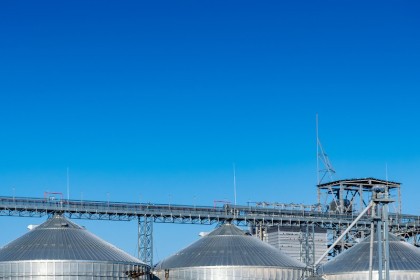
Concern About Frost On Late Planted Crops
by Linda Greyling, Product Portfolio Manager: Nutrition
With some late plantings this season, there is a real possibility that frost will impact on some crops this autumn causing stress to the plant and risk to the farmers. In this article we present a potential risk mitigation strategy based on the available research in order to safeguard yields under unfavourable weather conditions.
The minimum temperature (known as the “critical” temperature) which must be reached before damage occurs may be influenced by many factors. These include plant species, variety, growth or development stage, plant vigour, soil conditions, surface cover, freeze intensity and duration, thawing conditions, cloud and wind conditions during the freeze and others. A healthy growing plant can often withstand a frost better than a weak plant.
What causes frost?
Clear, calm and dry nights following cold days are the precursor conditions for a radiation frost. These conditions are most often met during winter and spring where high pressures follow a cold front. When the loss of heat from the earth during the night decreases the temperature at ground level to zero, a frost occurs. Wind and cloud reduce the likelihood of frost by decreasing the loss of heat to the atmosphere. The extent of frost damage is determined by how quickly the temperature takes to get to zero, the length of time its stays below zero and how far below zero it gets. There are two types of frost, “white” and “black”.
“White” frost occurs when the air around the plant is moist and the temperature around the plant is zero or below. Ice crystals form on the surface of the plant. The water in between plant cells freezes and draws water out of surrounding cells to form more ice. When frost melts slowly (in the winter) damage is minor. In spring, the thawing can be rapid and damage can be severe.
“Black” frost occurs when the temperature drops below zero but the surrounding air is dry. Ice can’t form on the plant surface and the water between cells freezes quickly and forms large crystals. These large crystals “pop” holes in the cells causing permanent damage. Frost damage occurs to legume pods and seeds, canola pods, flowers and seeds and cereal grains, flowers, or whole heads if the stem freezes around the flag leaf or in the boot. Flowering wheat, triticale, podding canola and field peas are some of the most sensitive crops to frost. Barley and oats are the most tolerant 2.
Various methods to control frost:
Bacterial control:
One strategy for frost management is to ensure that leaf surfaces are free of ice nucleation active (INA) bacteria. The higher the concentration of the INA bacteria, the more likely that ice will form. After forming, the ice then propagates inside the plants. Pesticides (typically copper compounds) are used to kill the bacteria and reduce concentrations of INA bacteria 3.
Increasing the brix of the crop:
A second strategy is to manage the temperature at which catastrophic damage may occur. This is different for different types of crops, but is usually between -5.5˚C and 0˚C 4.
Brix is a measure of sugars and minerals dissolved in water, and in our case plant sap 5, however, other chemicals such as amino acids and lipids may be present and contribute to the Brix reading 6. We measure brix levels of plant sap using a refractometer.
Plants protect themselves against frost by a process called acclimatisation. They will store osmotically effective substances such as sugar and potassium within their cells which serve as antifreeze agents by lowering the cell sap’s freezing point. In this way cell functionality is maintained at low temperatures. The sugar required for this process is produced by the plant itself, via photosynthesis. This process requires potassium, but also magnesium. Plants that have a higher brix level are less prone to frost. We know that pure water freezes at 0˚C, However, a 5 brix water-sugar mixture freezes at -3.3˚C; a 10 brix mixture at -5.5˚C and a 15 brix mixture won’t freeze until it reaches -8˚C 7.
If crops are already established, and this is normally the case with late season plantings, fertilisers cannot be applied to the soil and so foliar application can be considered. Foliar nutrients have the ability to prevent or to alleviate a wide variety of stress conditions. Injury from environmental conditions leads to stress induced nutrient deficiencies, either by interfering with normal uptake of nutrients from the roots or by the loss of carbohydrate reserves from cell loss.
The following nutrients are considered to play major roles in recovery from freeze damage or in hardening-off for drought resistance. The program to be applied will vary depending on the desired response 8.
Zinc (Zn): Zinc is important for its ability to influence auxin levels. Normal auxin functions are likely to be disrupted in freeze-damaged trees. Maintaining adequate hormone levels gives the tree a competitive advantage to withstand adverse conditions 8.
Manganese (Mn): Manganese, foliar applied in early season, tends to give a vegetative response less pronounced than Nitrogen but longer lasting in effect. Manganese is also essential for metabolism of carbohydrates. The result is a boost to early growth to promote recovery from freeze damage 8.
Phosphorous (P): Phosphorous is the principal element involved in plant energy processes because of the role of ATP in recovery 9. Phosphate levels may be low due to dry soil conditions or impaired root uptake and should be reinforced for cold stress 8. Phosphorous is involved in several key plant functions, including energy transfer, photosynthesis, transformation of sugar and starches and nutrient movement within the plant.
Potassium (K): Potassium is the major nutrient lost in the cell leakage that results from freeze injury and needs to be boosted prior to a freeze event. Potassium also promotes root development and is responsible for many vital processes such as water and nutrient transportation and protein and starch synthesis. It is a critical part of a program for both freeze recovery and drought hardiness. Potassium is very active in plant-water relations where it serves an osmo-regulatory function. It has been well documented that K plays a role in photosynthesis by regulating stomatal opening and closing 10. Increasing K fertilization is believed to promote osmotic adjustment, helping to maintain positive turgor pressures at low leaf water potentials and improving the ability of plants to avoid drought stress 14.
Calcium (Ca): Calcium is important for cell-wall structure, but calcium is also a major controller of plant metabolism and development 12. Calcium is considered to play a role in mediating stress response during injury, recovery from injury and acclimation to stress. It has been suggested that Ca is necessary for recovery from freeze injury by activating the plasma membrane enzyme ATPase which is required to pump back the nutrients that were lost in cell damage 9.
Silicon (Si): The role of Si in enhancing the tolerance of plants to various abiotic stresses, has been widely recognised 13. It has been reported that Si treatment leads to alleviation of frost damage by improving leaf and stem strength through deposition in the cuticle 14.
If a foliar application of fertiliser is planned on a crop, measure brix levels and then spray a small test plot of the crop with different foliar nutrients. After 2 hours, retest the plots to see which nutrient provided the biggest increase in brix. This represents the best choice of nutrient to apply prior to the on-set of conditions conducive for frost.
Inducing plant resistance:
Salicylic acid (SA): The role of SA in plant growth and development, flowering, ion uptake, stomatal regulation and photosynthesis has been extensively investigated 15. However, some recent studies have reported on the beneficial effects of SA on freezing injury. These studies demonstrated that SA and methyl salicylate (MeSA) treatments increased resistance to chilling injury in maize plants and tomato fruit 16. Freezing injury was decreased 19% by 0.01% solution treatments with salicylic acid.
Seaweed: Seaweed contains auxins, abscisic acid, brassinosteroids, cytokinins, gibberelins, polyamines and phlorotannins 17. The combined effect of these compounds lead to a healthier and stronger plant. This increases the plant’s tolerance against abiotic stresses like drought and frost.
Conclusion:
Although no guarantees can be given and the success of preparing plants for frost is dependent on the crops, variety and severity of the frost, each farmer should consider a strategy to minimise the damage to his crops as far as possible. AECI® Plant health has a range of products which can be considered in this strategy and have a program that has proven itself to be very effective against the prevention of frost over the past two seasons.
References
- http://www.omafra.goc.on.ca/english/crops/facts/85-116.htm#freez>
- https://grdc.com.au/resources-and-publications
- http://www.fao.org/3/y7223e/y7223e08.htm
- https://fruitgrowersnews.com/article/protecting-your-fruit-from-frost-and-freeze/
- Brix. Bionutrient Food Association. http://bionutrient.org/bionutrient-rich-food/brix 14 Oct, 2014.
- The Use of Refractometers. Integrity soils. http://www.integritysoils.co.nz/tag/photosynthesis/ 15th Sept, 2014.
- Harrill, R. Using a Refractometer to Test the Quality of Fruit and Vegetables. (1994). http://www.crossroads.ws/brixbook/BBook.htm#GENTLE WARNING
- https://nutrienttechnologies.com/2018/02/20/foliar-nutrient-programs-freeze-recovery-drought-resistance/
- Palta, J. P. Stress Interactions at the Cellular and Membrane Levels. HortScience 25(11):1377
- Meidner, H. and C. Willmer. Mechanics and Metabolism of Guard Cells. Current Adv. Plant Sci. 17:1-15 (1975).
- Eakes, D. J., R. D. Wright and J. R. Seiler, J. Am. Soc. Hort. Sci. 116(4):712-715 (1991).
- Poovaiah, B. W. and A. S. N. Reddy. Calcium Messenger Systems in Plants. CRC Crit. Rev. Plant Sci. 6:47-102.
- Matichenkov VV, Ammosova YM, Bocharnikova EA (1997) The method for determination of plant available silica in soil. Agrochemical 1, 76-84;
Epstein E (1999) Silicon.Annual Review of Plant Physiology 50, 641-664
- Ohyama N(1985) Amelioration of cold weather damage of rice by silicate fertilizer application. Agriculture and Horticulture Journal 60, 1385-1389.
- Pancheva T.V., Popova L.P and Uzunova A.N 1996. Effects of salicylic acid on growth and photosynthesis in barley plants. J. Plant Physiol. 149: 57-63
- Janda T., Szala G. Tari I. and Paldi E. 1999. Hydroponic treatment with salicylic acid decreases the effects of chilling injury in maize (Zea mays L) plants. Planta 208: 175-180.
Ding C.K, Wang C.Y., Gross K.C. and smith D.L 2002.Jasmonate and salicylate induce the expression of pathogenesis-related-protein genes and increase resistance to chilling inujry in tomato fruit.Planta 214: 895-901
- Stirk WA, Arthur GD, Lourens AF, Novak O, Strnad M, van Staden J 2004. Changes in cytokinin and auxin concentrations in seaweed concentrates when stored at an elevated temperature. Journal of Applied Phycology 26: 561-567
Papenfus HB, Stirk WA, Finnie JF, Van Staden J 2012.Seasonal variation in the polyamines of Ecklonia maxima.Botanica marina 55:539-546
For other agricultural products and services, click here.












